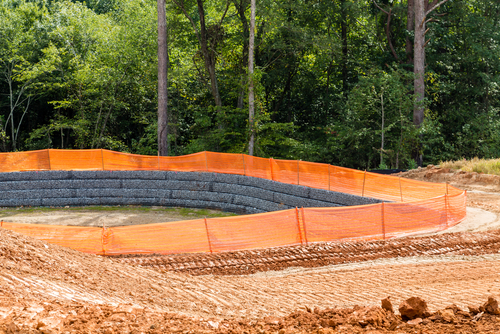Dealing with silty water from construction sites
Silt and sediment control on construction sites
What you must do
 You must not discharge silty water to a watercourse as it can cause pollution.
You must not discharge silty water to a watercourse as it can cause pollution.
You must treat silty water prior to discharge to ensure that the silt settles out. This requires the use of lagoons, settlement tanks or grassy areas that slow the water down enough for the solids to drop out.
Removing silt
Before you start work, identify and mark out any areas of land you intend to use for sacrificial or temporary surface water drainage measures. This may include temporary settlement ponds or Sustainable Drainage Systems (SuDS).
Design and construct these areas so that they can accommodate the run-off from your work. If this is not considered before you start work it can be difficult to fit it around work that has already begun.
Ensure that any water you discharge over ground does not enter field drainage systems or highway drainage systems. These systems usually lead to streams or watercourses and you will be liable for any resulting pollution.
Clean water that has gathered in the base of an excavation or clean water discharged from a settlement tank can be pumped out over adjacent ground as long as you:
- only pump over land that is part of your site or you have permission from the landowner to pump
- pump at a rate that allows the water to be quickly absorbed into the ground
- move the discharge point around to prevent ponds forming
- don't pump onto land that is already saturated, as this can lead to pollution if water flows overland and into a watercourse.
Do not pump water onto areas that have been stripped of vegetation or topsoil as it is likely to pick up high levels of silt. If this water enters a watercourse, it could cause pollution.
CIRIA have produced a document called 'Control of Water Pollution from Construction Sites - Guidance for consultants and contractors C532' (2001) which outlines methods of water control including retention time calculations for settlement lagoons.
Information can also be found in 'Pollution Prevention Guideline (PPG) 6: Working at construction and demolition sites.
GPP 6 Working on construction and demolition sites
Guidance for Pollution Prevention (GPP) 5 contains guidance on measures you can take to avoid causing pollution during building and engineering work.
GPP 5 Works and maintenance in or near water (Adobe PDF – 782KB)
SEPA: Silt control while dredging 2015
General Binding Rules (GBRs) for discharges of run-off water (GBR 10 and 11)
GBR 10 - Discharging water from a surface water drainage system
In Scotland, GBR 10 details the rules relating to discharging water from a surface water drainage system.
GBR 10 has been updated to cover surface water discharge from:
- land used for residential purposes (up to 60 hectares).
- land used for non-residential premises or yards (excluding industrial estates).
- car parks with up to 1,000 spaces.
- metalled roads (excluding motorways and A roads).
- waterbound roads.
and
- constructions sites, where the site, including any constructed access tracks does not:
- exceed 4 hectares.
- contain a road or track longer than 5km.
- include any area more than 1 hectare, or any length of more than 500m on ground with a slope of more than 25°.
If your site exceeds these thresholds then you will require authorisation from SEPA : Construction site licences.
GBR 10 specifies that all reasonable steps must be taken to ensure pollution does not occur.
The discharge must not:
- contain trade effluent/sewage.
- result in discolouration, iridescence, foaming or growth sewage fungus.
- destabilise banks or bed of the receiving surface water.
- contain run-off from fuel delivery areas, vehicle loading/unloading bays where potentially polluting matter is handled or oil and chemical storage, delivery and handling areas. if constructed on or after 1st April 2007.
All parts of the surface water drainage system must be maintained in good working order and repair and steps must be taken to ensure that matter liable to block or obstruct the drainage system is prevented from entering.
Construction specific rules:
Sites must be drained to a Sustainable Urban Drainage System (SUDS) unless the discharge is from a single dwelling or to coastal waters.
All parts of the construction site which began operations on or after 01 June 2018, on which works are to be undertaken or any vehicles are to be operated or parked on, must be drained by a surface water drainage system with the capacity to accommodate the maximum volume of run-off expected to occur from the land during the period of construction.
